Drill a hole - choose a place and time
Before starting the construction of an autonomous water supply system, it is necessary to determine the location of the object on the site. This is a very crucial moment, on which the effectiveness, convenience and price of the project, as well as the nuances of obtaining permits, will depend.
We will tell you where and when it is better to develop a source of drinking water.
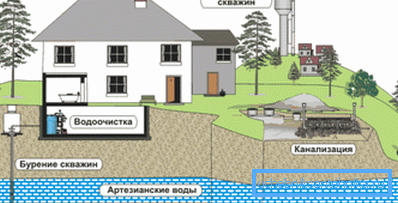
Location on the site
General information

It is possible to locate a well on a site anywhere, but with some reservations:
- Is it possible to drill a well under the house? It is possible, but only if it is an Abyssinian well or a shallow hole on the sand, otherwise you simply cannot drive a drilling installation into the basement. The subsequent repair and maintenance of the facility will also be difficult, so there is a lot to think about, although the savings from such a decision are quite substantial;
- You should not choose the lowest point of the site, as during the floods the caisson will be flooded and access to it will be difficult. There will also be a danger of contamination of the aquifer with upper water and sedimentary water. Finally, the maximum slope towards the source should not exceed 35 angular degrees;
- The distance from the water source to the house is better to choose the minimum, but not less than 3 meters. The closer the well - the lower the cost of pipes and earthworks, as well as lower load on the pump motor;
- The distance from the well to the nearest source of infection - septic tank, toilet, cesspool or compost pit, burial sites, dumping sites, livestock and domestic animals - at least 50 meters, usually from 50 to 100 m;
- If the work with your own hands is impossible, then it is better to foresee the method of driving the equipment to the site and its location on it, as well as sufficient free space around and above the installation for all manipulations;
- You may need a location for a kunga or trailer for workers.
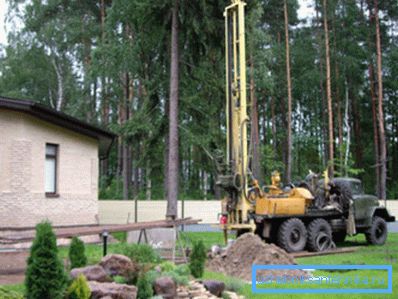
Note! Drilling equipment has a considerable weight and size, so you should understand that the landscape of the site will be broken. This should be considered when planning work.
Artesian well
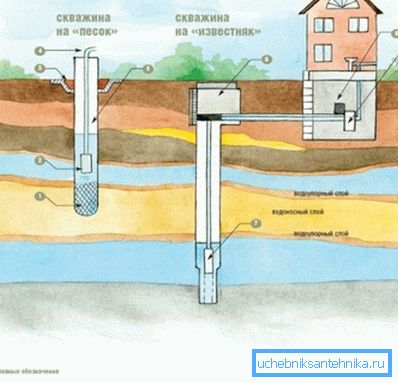
If an Abyssinian well and a sandy hole can be positioned almost anywhere, then for the construction of an artesian source it is necessary to provide some points..
Let's list the characteristic differences of this structure:
- An artesian well, with rare exceptions, draws water from limestone aquifers. The depth of their occurrence is usually not less than 50 - 100 meters, so it is almost impossible to dig it out yourself. Consequently, you will need equipment and a team of workers;
- The Artesian source crosses two or more aquifers, which carries the danger of liquid overflow and mixing of water from different horizons, and this is unacceptable. Therefore, casing strings and possibly tamponage will be needed, which will also affect the condition of the site;
- Water from limestone horizons is considered a strategic reserve of the state, so a permit will be required to open the reservoir and install the well. As a rule, the project of the future facility is made up jointly with the organization that performs the drilling, and the location will be chosen by the specialists and engineers of the drilling company, and later it will be approved by the supervisory authority issuing the permit and license;
- It is possible to equip an artesian source for two or three separate farms, which is beneficial from an economic point of view. At the same time, the search for a location is made taking into account considerations of the mutual benefit of neighbors;
- When developing the rock, a drilling fluid can be used, which will be poured onto the site, leaving a layer of clay and mud.
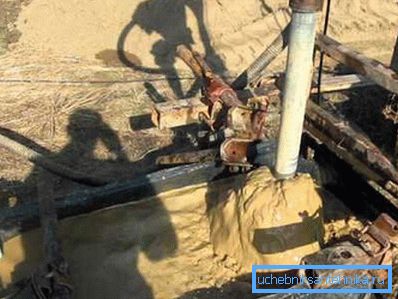
In addition, you should think through the logistics in advance. The fact is that for free passage of the installation and auxiliary equipment you will need a path not less than 3 meters wide. To install and place the tower with a car, you need a rather large area - about 4x9 meters.
It is also necessary to provide a place for the placement of a water carrier with drilling mud, a trailer for the working crew, drill rods and other tools. May need power cable connections.
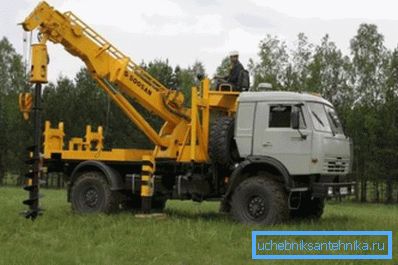
Another important point: the height of the oil rig is about 10 meters, so you should ensure the free space above the equipment, eliminate large branches, pipes and all kinds of wires. Drilling under high-voltage lines and gas mains is strictly prohibited!
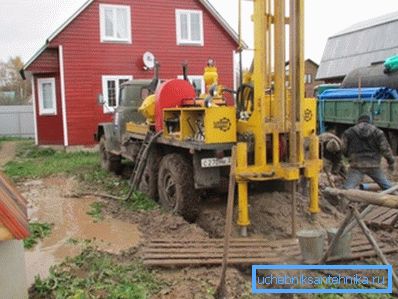
Finally, the drill string will be assembled in the aft part of the installation, and this will require at least six meters of free space.
Note! It is worth discussing with the representatives of the drilling company the routes and directions of possible maneuvers and coordinate them with the landscape of your site in order to minimize the damage.
Time to work

Since modern drilling rigs are able to work at any time of the year, consider the features of each season:
- Summer time is traditionally considered optimal for any construction, including for the construction of wells. At this time, there is a natural drainage of the soil, which greatly facilitates the search for the aquifer, in addition, work contributes to a comfortable temperature and condition of the rock. The disadvantage is the large influx of customers from drilling companies, which leads to haste and lower quality due to speed;
- Autumn time, especially its first months, is considered optimal for drilling shallow (up to 25 meters) wells. At this time, the temperature remains acceptable, the soil is still quite dry, the soil is not frozen. Often, in the fall, they are burying to the depth of freezing to continue in winter;
- Winter is also suitable for drilling, since during this period the work does not interfere with precipitation, and the soil at the site is very strong and does not collapse under the wheels of the trucks. Also in winter the upper layers are less mobile, which facilitates the work. The influx of volunteers drops sharply, and drillers have no time limit;
- Spring is considered the worst time to start drilling, as high groundwater levels make it difficult to determine the aquifer. In addition, the soil on the site is blurred with melt water, and heavy equipment quickly turns the site into a continuous mess of mud. Otherwise, this period is also quite suitable for development, but drilling companies reluctantly agree to work during the flood.
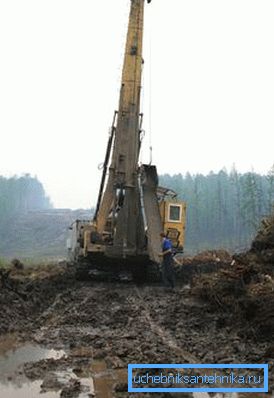
Note! Based on this modest information, you can quite specifically determine the most appropriate time for work. If you carefully read the list, it is easy to find that each season has its advantages and disadvantages, except, perhaps, spring, when the disadvantages clearly outweigh the advantages.
Conclusion
The choice of meta to place a well on the site is an important and crucial task. We found out where to drill a well - outside or inside, and also considered all the important points, starting with the size of the equipment, and ending with the season for work. The video in this article further illustrates this.